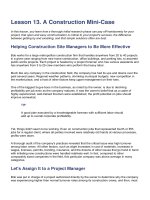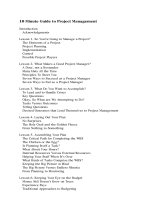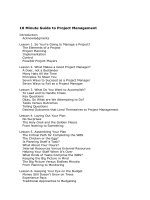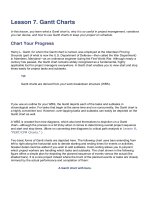Lession 01 Introduction to Project Management
Bạn đang xem bản rút gọn của tài liệu. Xem và tải ngay bản đầy đủ của tài liệu tại đây (2.87 MB, 77 trang )
Lession 1:
Introduction to Project Management
2
Learning Objectives
Understand the growing need for better project
management.
Explain what a project is, provide examples of projects, list
various attributes of projects, and describe the triple
constraint of projects.
3
Learning Objectives
Describe project management and discuss key elements of the
project management framework, including project
stakeholders, the project management knowledge areas,
common tools and techniques, and project success factors.
4
Learning Objectives
Understand the role of the project manager by describing
what project managers do, what skills they need, and what the
career field is like for project managers.
5
Learning Objectives
Describe the project management profession, including its history,
the role of professional organizations such as the Project
Management Institute, the importance of certification and ethics
6
Learning Objectives
Describe the five project management (PM) process groups,
the typical level of activity for each, and the interactions
among them.
Understand how the PM process groups relate to the PM
knowledge areas.
Discuss how organizations develop information technology
PM methodologies to meet their needs.
7
Learning Objectives
Review a case study of an organization applying the PM process
groups to manage an information technology project, and
understand the contribution that effective project initiation,
project planning, project execution, project monitoring and
controlling, and project closing make to project success.
8
Introduction
Many organizations today have a new or renewed interest in
project management.
Computer hardware, software, networks, and the use of
interdisciplinary and global work teams have radically changed
the work environment.
*PMI, The PMI Project Management Fact Book, Second Edition, 2001.
9
Advantages of Using Formal
Project Management
Better control of financial, physical, and human resources.
Improved customer relations.
Shorter development times.
Lower costs.
10
Advantages of Using Formal
Project Management
Higher quality and increased reliability.
Higher profit margins.
Improved productivity.
Better internal coordination.
Higher worker morale (less stress).
11
What Is a Project?
A project is “a temporary endeavor undertaken to create a
unique product, service, or result.”*
Operations is work done to sustain the business.
*PMI, A Guide to the Project Management Body of Knowledge
(PMBOK® Guide) (2004), p. 5.
12
What Is a Project?
A project ends when its objectives have been reached, or the
project has been terminated.
Projects can be large or small and take a short or long time to
complete.
13
Project Attributes
A project:
Has a unique purpose.
Is temporary.
Is developed using progressive elaboration.
14
Project Attributes
Requires resources, often from various areas.
Should have a primary customer or sponsor.
The project sponsor usually provides the direction and
funding for the project.
Involves uncertainty.
15
Project and Program Managers
Project managers work with project sponsors, project teams, and
other people involved in projects to meet project goals.
Program: “A group of related projects managed in a coordinated
way to obtain benefits and control not available from managing
them individually.”*
Program managers oversee programs and often act as bosses for
project managers.
*PMI, A Guide to the Project Management Body of Knowledge
(PMBOK® Guide) (2004), p. 16.
16
The Triple Constraint
Every project is constrained in different ways by its:
Scope goals: What work will be done?
Time goals: How long should it take to complete?
Cost goals: What should it cost?
17
The Triple Constraint
It is the project manager’s duty to balance these three often-
competing goals.
18
Figure 1-1. The Triple Constraint of
Project Management
Successful project
management means
meeting all three
goals (scope, time,
and cost) – and
satisfying the
project’s sponsor!
19
What is Project Management?
Project management is “the application of knowledge, skills, tools
and techniques to project activities to meet project
requirements.”*
*PMI, A Guide to the Project Management Body of Knowledge
(PMBOK® Guide) (2004), p. 8.
20
Figure 1-2. Project Management
Framework
21
Project Stakeholders
Stakeholders are the people involved in or affected by project
activities.
22
Project Stakeholders
Stakeholders include:
Project sponsor
Project manager
Project team
Support staff
Customers
Users
Suppliers
Opponents to the project
23
Nine Project Management
Knowledge Areas
Knowledge areas describe the key competencies that project
managers must develop.
Four core knowledge areas lead to specific project
objectives (scope, time, cost, and quality).
Four facilitating knowledge areas are the means through
which the project objectives are achieved (human
resources, communication, risk, and procurement
management).
24
Nine Project Management
Knowledge Areas
One knowledge area (project integration management)
affects and is affected by all of the other knowledge
areas.
All knowledge areas are important!
25
Project Management Tools and
Techniques
Project management tools and techniques assist project managers
and their teams in various aspects of project management.









